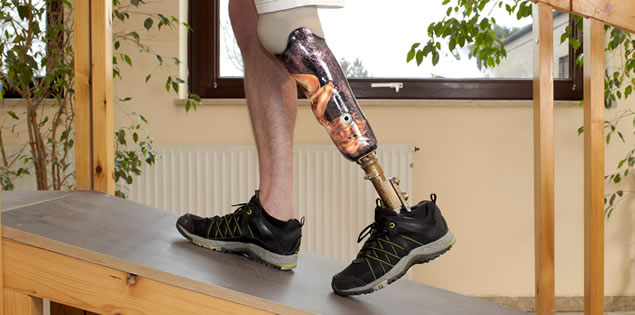What is residual limb pain (RLP)? This is the pain that originates in the remaining part of your limb. It can be caused by a variety of conditions related to your surgery or it can be caused by conditions you had prior to your amputation. You and your healthcare team will want to work together carefully to understand the origin and cause of your pain in order to treat it successfully. Possible causes of residual limb pain include:
- Underlying disease process such as skin problems and infection and nerve pain (neuropathy), especially if you have diabetes or circulatory problems
- Surgical trauma, including decreased blood supply to your limb or poor tissue coverage at the end of the bone
- Neuroma formation
- Entrapment of nerves in scar tissue.
Underlying Disease Processes
Key to managing symptoms of pain that have to do with a pre-existing condition like diabetes is to make sure that the condition is managed as well as possible.
For example, if you have diabetes, keep your blood sugar under good control. If you have poor circulation, follow your physician’s instructions for diet, exercise and medications.
Managing pre-existing conditions after surgery is as important as ever.
Surgical Trauma
Poor tissue coverage can be caused by the bone at the end of your residual limb not being properly trimmed at the time of surgery, and this can cause pain when you wear your prosthesis. If padding and other methods are not successful, surgery may be required to revise your residual limb so as to decrease your pain and allow you to wear your prosthesis.
Neuromas
A neuroma is a collection, or bundle, of nerve endings that forms under the skin of your residual limb. Think of it like a tangle of hair. It can become very sensitive, especially if the tangle is pressing against your prosthesis.
Because neuromas are made up of nerve endings, possible treatments include medications that help with nerve pain, such as:
- Non-steroidal anti-inflammatory medications
- Specific antidepressants and anticonvulsants that have been found to be effective for nerve pain
- Steroid injections.
Non-medication options include:
- Ultrasound, which is essentially a machine that uses sound waves to generate heat within a body part; it can help increase blood flow so that inflammation and swelling can be decreased
- Massage, which also helps decrease inflammation and helps desensitize your residual limb to touch
- Vibration, which creates a mild shaking to contract muscles, to decrease inflammation and pain
- Percussion/finger tapping at the point of pain, which also helps desensitize your residual limb
- Acupuncture, manipulating thin, solid needles that have been inserted into specific acupuncture points in the skin
- TENS (transcutaneous electrical nerve stimulation), which produces a mild “pins and needles” sensation, overriding some of the pain that your body is producing.
Modifying the prosthesis socket to prevent rubbing at the sensitive part of your limb may also be helpful.
Unfortunately, surgery to remove neuromas is not usually successful, because they often simply reform.
Heterotropic Bone
Occasionally, excess bone forms abnormally around the end of the amputated limb; this is sometimes called a “bone spur.” The “extra” bone may cause pressure points that interfere with the fit of your prosthesis; this occurs more frequently in children than adults. If the problem cannot be solved with changes to the prosthesis, surgery can remove the excess bone. For children, this is best done after the bone stops growing.
Entrapment of Nerves in Scar Tissue
As your incision begins to heal, your doctor will let you know when you can start massaging your residual limb. This will help to prevent nerves from being “caught” in scar tissue. You will also be taught how to wrap your limb using elastic wraps. This not only helps to prevent scarring but also helps with prosthesis fit.
Normal Postoperative Pain
After surgery, your postoperative pain will diminish over the first few weeks. After you are discharged from the hospital, you may still be taking pain pills, but should be able to decrease the number of pills fairly quickly.
Methods to decrease swelling will also help reduce your pain, including elastic wraps and residual limb socks, light massage and finger tapping, and cold packs. Residual limb pain is different from this normal postop pain. For example, it commonly occurs after your postoperative pain has ended. It is frequently described as sharp, aching, throbbing or burning in nature. Your entire healthcare team, including your doctors, therapists and prosthetist, will work with you to determine the cause of this pain and decide what treatments might be most effective.
Pain Management Principles
No matter the cause of residual limb pain, the following methods can help you manage your pain.
- Begin exercises as soon as your surgeon allows it. Standing, walking and muscle stretching not only improve your general health, but also interrupt pain signals.
- Desensitize your residual limb, following the instructions of your physical or occupational therapist; this includes both massaging and wrapping your residual limb.
- Work with your prosthetist to maintain proper prosthetic alignment and to choose prosthetic components that are appropriate to your needs.
- Keep a pain journal. Keeping track of your symptoms and sharing them with your healthcare team will help you find the right treatments for you.
- Practice relaxation. We know that tension and stress increase pain. It is estimated that 50 percent of pain can be reduced by relaxation.



